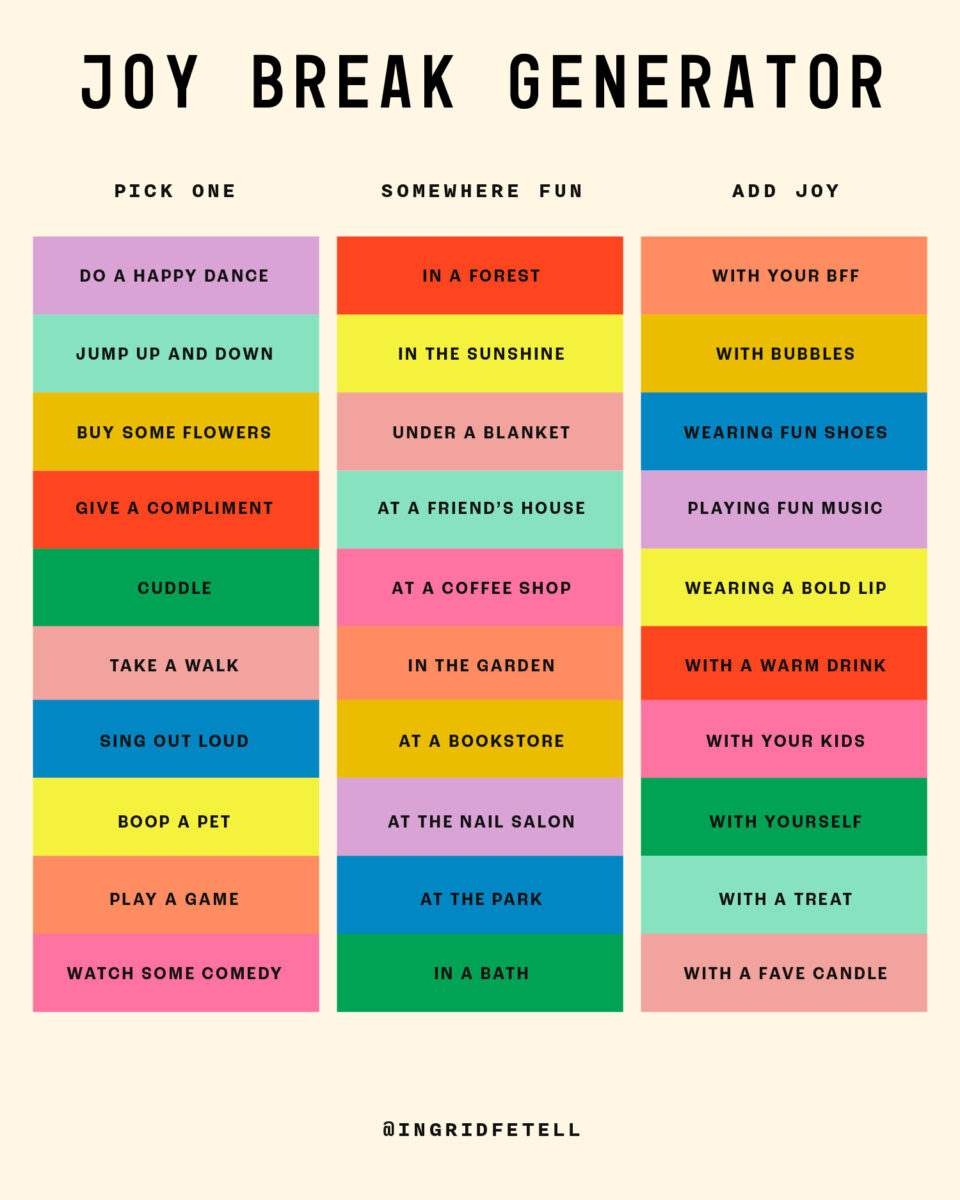
The day went bad early.
I hadn’t worked out all week, and was planning to get up before my toddler woke up to squeeze in twenty minutes of weights, but overslept. I barely had time to shower before it was time to start getting the kiddo ready for school. I was behind on preparing for a presentation that afternoon. And then when I went to rehearse, I discovered my clicker wasn’t working. Interruptions were constant, I didn’t have time to eat lunch, and then, someone made a small mistake right at the moment when I was crankiest and hungriest, and BOOM. Like a stick of dynamite in a roadrunner cartoon I exploded, creating a storm of tears and guilt. And I still had to give a presentation about joy, something I felt highly unqualified to talk about in that moment.
Like death and taxes, hard days are a fact of life. But a few years ago I had a simple mindset shift that radically changed how I experience them.
How to Cheer Yourself Up on a Hard Day
In the past, I used to see a bad day as something to grit my teeth and get through. Once a day started turning bad, it was a lost cause. The best I could do was hide under the covers and just try to make it through to the other side.
But when I learned the difference between joy and happiness, I realized that because joy happens in small moments, it can really happen at any time. Even on a hard day. This might not sound like a big deal, but here’s why it matters.
Embrace Small Moments of Joy
If you think a bad day is irredeemable, then you close yourself off to opportunities for joy. You’re just trying to get through it, and small moments of joy feel silly and pointless, a distraction from the effort of surviving the bad day. So you ignore the funny text from a friend, and you go through the motions with your kids. Instead of getting outside for a few minutes, you slump over your computer banging out emails because at least then you’ll get to go home sooner.
But if you believe that small moments of joy can still find you on a hard day, then you stay open to the possibility of joy. You’re available for it when it happens. And even though you know it won’t fix everything, you can still let a few rays of light in. This short video, which I recorded when my basement flooded last year, breaks it down a little more.
The thing about many bad days is that they’re often a sum of a lot of little things going wrong. And in a month or a year, you may not even remember what was so bad about them. But if you open yourself up to joy, you might remember your spouse making you laugh through your tears with their impression of your boss, or how you found a feather on a walk, or that your dog made a new friend at the dog park. These moments might seem small, but they can lead to upward spirals, which can have a strongly positive effect on your overall mental health.
So how do you find a little joy on a hard day? Here are twelve tips, many backed by scientific research, that can help you turn your day around.
Look For Micromoments of Joy
If the idea of finding joy just feels too hard, ask yourself: What is the tiniest possible form of joy I could find today? Maybe that’s whipped cream on your coffee. Maybe it’s taking off your shoes and feeling grass under your feet. Maybe it’s listening to a favorite song, or noticing the dappled light under a favorite tree.
Researchers call these tiny moments glimmers, a term coined by social worker Deb Dana, and they can be anything that gives you a brief sense of joy or peace. One of my favorite ways to find glimmers is to look for “oddly specific joys.” These are mundane things like peeling an orange in one piece or the moment of silence when you drive under an underpass during a hard rain that focus your attention on the magic of everyday life.
Get Outside
It just takes five minutes outside to improve your mood and help you get perspective, according to a 2018 study. Go for a short walk, putter in the garden, or sit in the sunshine. Even the littlest dose of greenery and fresh air can help reduce negative thoughts and rumination.
Make Joyful Movements
When we’re struggling, we often hold stress in our bodies unconsciously. Practically speaking, that means keeping tension in our muscles and tucking our tailbones, rounding the shoulders and closing off the body to others. This posture is very similar to what animals do when they are fearful, and may be primal evolutionary response that helps protect internal organs from danger.
This closed off body posture, however, prevents deep breathing and keeps us feeling braced. To counteract it, you can make expansive movements that mimic the natural posture of a body in a state of joy. This might mean raising the arms up and spreading them out in a Y shape, arching the back, and lifting up the head. (For more on why this works, see here.) You can also jump up and down to increase blood flow, do a happy dance, or some other form of exuberant physical activity.
Research now shows that people suffering from depression are more likely to have altered body posture (head tilted down and forward in a kind of slump) and movements (slower, shorter steps and smaller range of motion) compared with a control population. Consciously changing posture and movement resulted in improved emotional states, suggesting that these kinds of interventions might also be useful as part of a broader treatment plan for depression.
Look Up
Just as we close off our bodies when we’re feeling stressed, we also tend to look down. This downward gaze keeps us from making eye contact with others and decreases what we can see from our peripheral vision. This closed off field of view keeps us focused on our troubles, and reduces the chances of seeing something (a beautiful sunset, a smile from a compassionate stranger) that might shift our mood.
Nudging yourself to look up can help shift this pattern. Looking up also increases the amount of light that gets into the eye. This is important because light helps downregulate melatonin (making us feel more energetic) and also plays a role in regulating serotonin, an important neurotransmitter for mood. All of which may help us feel happier.
Sing Out Loud
A number of studies have shown that singing, particularly singing with others, can reduce stress and boost mood. Singing together also promotes feelings of connection and belonging, which can buffer the stress of a bad day.
Though many studies of singing are conducted with choirs, you can try just singing with a best friend, your kids, or along with the radio.

Dress For Joy
After a bad cold had me feeling sluggish for nearly two weeks straight, I decided to turn to the power of lipstick. A quick swipe of red later, and the face looking back at me from the mirror seemed bright and healthy.
We know that certain colors, such as red and yellow, increase alertness, so it makes sense that wearing bright hues could help give us a boost. In addition to my favorite red lipstick, I often wear my red sunglasses or glittery shoes on days when I feel blah.
Change the Temperature
There’s a growing body of research linking ambient temperature to emotion. Studies show that in general, warmer temperatures improve mood, though when it gets too hot, people increasingly get agitated. It’s not surprising, then, that when I asked our community on Instagram to share their favorite pick-me-ups, many mentioned the comfort of a warm drink or a warm blanket. Interestingly, a theory known as affect-gating suggests that we are more sensitive to touch (and less visually focused) when we’re in a sad mood, in part because a craving for warmth draws us toward social connection (which connotes safety).
On the flip side, the TIPP framework, which comes from a therapy modality known as DBT, promotes cold exposure as a way to take down the intensity of an emotion. If your tough day is making you feel “overheated,” a splash of cold water or an ice pack may be the way to go.
Play a Game
When you’re having a tough day, playing a game might be the last thing on your list. But here’s why you should consider it. Getting immersed in play has been shown to reduce our awareness of time and minimize self-consciousness. When we play we’re able to get out of our heads and be fully in the moment. Play can also stimulate the release of endorphins, our brain’s natural painkilling chemicals. Together, these benefits make play an ideal break from focusing on our troubles.
Read or Watch Something Funny
Many readers of this blog say they turn to comedy on a tough day, and research supports this approach. Studies show that laughter decreases the presence of stress hormones in the blood, helping to reduce the effects of stress on the body and mind. And, just like play, laughter also stimulates the production of endorphins.
I keep a “funny file” of memes and videos that always make me laugh. You can also turn to a favorite funny movie or romcom, or ask a friend to share something that’s cracked them up recently.
Talk to a Friend
One of the most powerful ways to get out of a bad mood? Reach out to a friend. The hardest thing about most tough days is that we often feel alone in our struggles. Talking to a supportive friend can help remind you that you are loved and that there are people who want to help you.
One thing that can help you feel supported on a hard day is to communicate clearly what kind of support you’re looking for. If you don’t want to problem-solve, let your friend know that you just need a listening ear, and you’ll come to them for advice when you’re ready.
Go Shopping (Yes, Really)
The conventional wisdom says to avoid shopping when you’re feeling low, to avoid the risk of impulse buying (and the regret that comes with it). But researchers have found that going shopping when you’re not feeling your best can actually have benefits, as long as you don’t go overboard.
Psychologists note that browsing shops (even online) can provide sensory stimulation that distracts us in a positive way from the things we’re struggling with. Even just filling up an online cart and then abandoning it sometimes gives us a meaningful joy boost, no purchase required.
Shopping for and acquiring something we really want can also help increase our sense of control at a time when life feels out of control. But to keep that feeling of control, it helps to make sure purchases are within budget. When in doubt, a small treat such as a new book, a fancy latte, or fresh flowers are ideal forms of retail therapy.
Plan something to look forward to
And if you can’t seem to find joy in the present, turn your attention to the future. In research, even having a small joy to look forward to (such as getting to watch a funny cartoon) boosted mood and reduced stress. Browse travel sites for your next trip, search local events calendars, or ping a friend to invite them over for dinner.
For More Inspiration
Try our Joy Break Generator to help you find a quick pick-me-up that is guaranteed to boost your mood. Choose one thing from each column to create your perfect joy break. Not sure what to pick? Look at your favorite color and see what comes up!

And for more perspective on how to find joy when you’re struggling:
- How feeling sad can actually help you find more joy
- What to do when everyone seems happy except for you
- 12 ways to be gentle with yourself




Discussion (6 Comments)
Hi!
The link to the list of questions to spark conversation didn’t work for me. Kept getting a 404 error message. Might want to check that. Thanks!
So sorry about that! Here’s the correct link: aestheticsofjoy.com/conversation-starters
Very timely and helpful, a lovely post – thank you ?
Hi – Love this and appreciate all the information. Is there a way to print out the Joy Break Generator? I would love to hang it on the fridge- so everyone can try it! Thank you for sharing your expertise and your joy. Kind regards.
Sure, you can download the image (ctrl click) and then print. Enjoy!
Yes, you can right click it and download the graphic, and then print it out that way 🙂